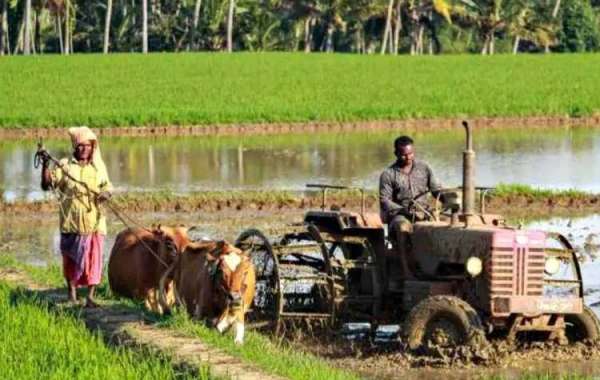Uttar Pradesh (UP), India’s most populous state with 238.9 million people, relies heavily on agriculture, which contributes 25% to its gross domestic product (GDP) and employs 47% of its population. The state’s fertile Indo-Gangetic plains make it a cornerstone of India’s food security, producing 17.83% of the nation’s food grains. In 2025, UP continues to lead in agricultural output while addressing challenges like small landholdings, low farmer incomes, and technological adoption through government initiatives, private partnerships, and events like AgroTech 2025. This article provides an overview of UP agricultural landscape, key crops, challenges, and recent developments as of May 2025.
Agricultural Significance in Uttar Pradesh
Agriculture is the backbone of UP’s economy, supporting 92% of smallholder farmers who depend on horticultural crops for their primary income. The state is the largest producer of food grains in India, with a recorded output of 51,252.7 thousand tonnes in 2017-18, and recent posts on X indicate a target of 725 lakh metric tonnes (72.5 million tonnes) in 2025, reflecting a significant increase. UP leads in the production of wheat, barley, sugarcane, potatoes, lentils, and mangoes, and is the top milk producer, contributing 16.83% of India’s total milk production (27.77 million tonnes in 2016-17).
The state’s agricultural growth rate, however, has lagged behind the national average, recording 3.0% per annum between 2005–19 compared to India’s 3.6%. Despite this, UP’s growth is less volatile, benefiting from its fertile plains and irrigation infrastructure, including 74,660 km of canals, 69 reservoirs, and 32,000 tube wells. Western UP is more advanced agriculturally, while eastern regions focus on traditional crops and handicrafts tied to agriculture, such as Bhadohi’s carpets.
Key Crops and Production
UP produces a wide range of crops across all seasons (Kharif, Rabi, and Zaid), reflecting its diverse agro-climatic zones:
- Food Grains: Major crops include rice, wheat, maize, millet (bajra), gram, peas, and lentils. In 2025, the Kharif season targets 293 lakh metric tonnes (29.3 million tonnes) of food grains, up from 256 lakh metric tonnes last year, as per recent posts on X.
- Cash Crops: Sugarcane is the most important cash crop, with UP being the largest producer in India. Lakhimpur Kheri is a key sugarcane district.
- Horticulture: UP is a leader in mango production (notably in Lucknow, Saharanpur, and Bulandshahr), and also grows bananas, guavas, papayas, and aonla (Indian gooseberry). In 2017-18, the state produced 28,226 thousand tonnes of vegetables, the highest in India.
- Specialised Crops: The Digital Agriculture Export Promotion Council (DAEP), established in 2023, focuses on potatoes, mangoes, spices (turmeric, garlic), and green peas for export growth.
- Livestock and Dairy: Livestock supports 15% of India’s population, with UP leading in milk production. Farmers are integrating animal husbandry, horticulture, and silk rearing to boost incomes, as noted in recent X posts.
Challenges Facing UP Agriculture
Despite its agricultural prowess, UP faces several hurdles:
- Small Landholdings: The average landholding size is 0.73 hectares (2015-16), below the national average of 1.15 hectares, limiting economies of scale.
- Low Farmer Incomes: In 2015-16, the average monthly income per agricultural household was Rs. 6,668, 25% lower than the national average of Rs. 8,931. This gap likely persists in 2025, given historical trends.
- Technological Adoption: Smallholders lack awareness and resources to adopt technologies like AI, blockchain, and Iot, which could transform supply chains.
- Resource Constraints: Insufficient investment in modern farming equipment and persistent power shortages hinder productivity. The state’s 2024-25 budget allocates only 3.1% of its expenditure to agriculture, significantly below the national average of 5.9%.
- Climate and Infrastructure: Monsoon dependency, coupled with occasional droughts and floods, affects yields. While irrigation infrastructure exists, power shortages for tube wells remain a bottleneck.
Government Initiatives and Developments in 2025
The UP government, in collaboration with private partners and the World Economic Forum, is implementing strategic initiatives to modernise agriculture and boost farmer incomes:
- Digital Agriculture Export Promotion Council (DAEP): Launched in August 2023, DAEP promotes agritech services, streamlines value chains, and enhances market connections for smallholders. It targets crops like potatoes, mangoes, turmeric, garlic, and green peas, aiming to double exports through partnerships with six private companies.
- AgroTech 2025: Scheduled in Lucknow at the Indian Institute of Sugarcane Research, this event, supported by the UP government and ICFA, will showcase the latest agri-input products, technologies, farming practices, and government schemes. It aims to provide farmers with exposure to modern tools and attract private investment in farm machinery, horticulture, dairy, and processed food.
- Export Goals: UP aims to triple farm exports by 2030, leveraging a 10% annual growth in agri-exports, organic farming, and the Ganga-Haldia waterway for cost-effective transport, as highlighted in recent X posts. The state is expanding access to international markets for fruits and vegetables.
- Natural Farming: The Agriculture Department promotes cow-based natural farming, with training programs along the Ganga River banks. An action plan worth Rs. 197.22 crores targets 38,670 hectares across 35 districts in 2025.
- Subsidies and Schemes: The UP Subsidy Scheme 2025 offers support for cultivators, harvesters, and tractors, simplifying access to subsidies through platforms like Tractor Junction. The state also promotes certified seeds and tech adoption to achieve its 725 lakh metric tonne grain output target.
- Infrastructure Development: The government is investing in high-tech nurseries, export promotion hubs, and agro-parks like the Mega Food Park in Baheri. The 2024-25 budget allocates 5.9% to roads and bridges, above the national average, improving market connectivity.
Opportunities and Future Outlook
UP’s agriculture sector holds immense growth potential:
- Agri-Processing: With the Indian food processing market projected to reach $535 billion by 2025, UP is well-positioned for investments in mango, turmeric, and aonla processing, as well as cereal manufacturing.
- Integrated Units: Agro-parks in Varanasi, Barabanki, and Chitrakoot offer opportunities for processing, preservation, packaging, and warehousing.
- Education and Research: Premier institutes like SHUATS Prayagraj, SVPUAT Meerut, and the Indian Veterinary Institute in Bareilly support agricultural innovation. The UPCATET 2025 exam, scheduled for May 16-18, facilitates admissions to agriculture and technology programs across UP universities.
However, the state must address systemic issues like low budgetary allocation and power shortages. While initiatives like DAEP and AgroTech 2025 are promising, their success depends on effective implementation and farmer outreach, especially for smallholders who form the majority.
Conclusion
Uttar Pradesh’s agriculture in 2025 remains a cornerstone of its economy, leading in food grains, sugarcane, and horticulture, while striving to overcome challenges through innovation and policy support. With a target of 725 lakh metric tonnes of grain output, ambitious export goals, and events like AgroTech 2025, the state is poised for growth. However, addressing smallholder constraints, increasing budgetary support, and ensuring equitable access to technology will be key to sustaining this momentum. UP’s agricultural future hinges on balancing tradition with modernisation, ensuring prosperity for its farmers and contributing to India’s food security.






